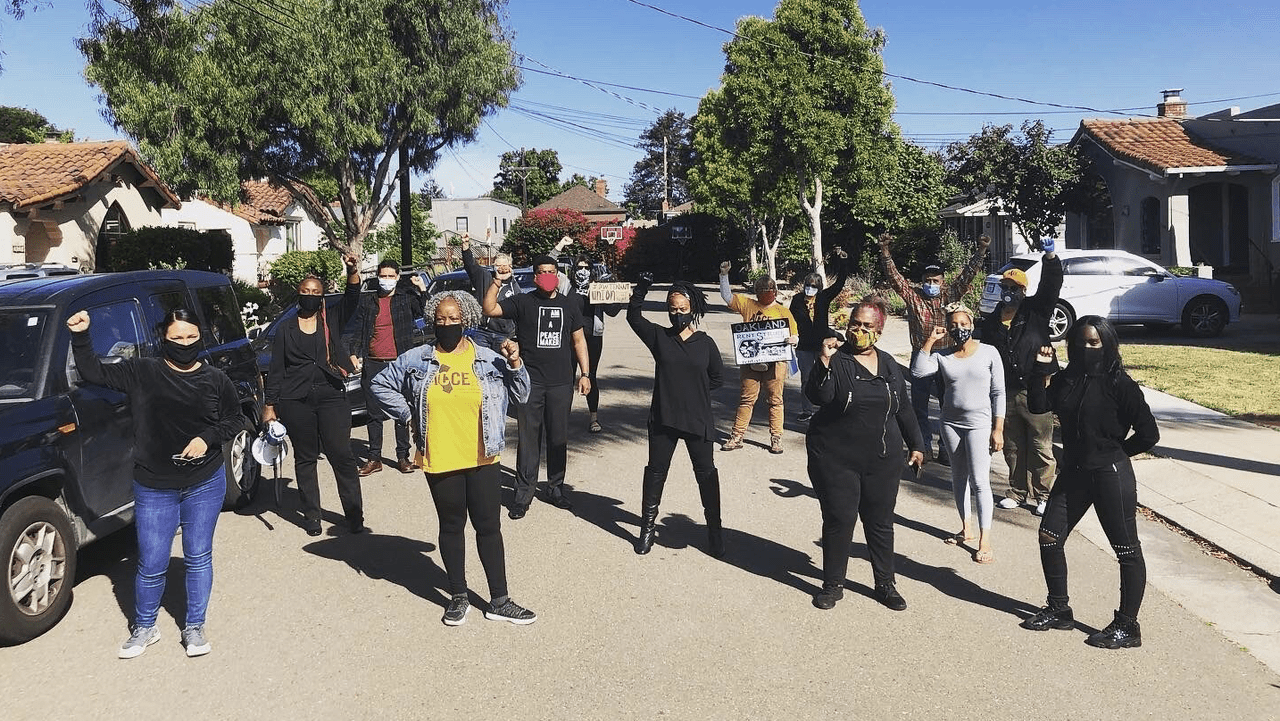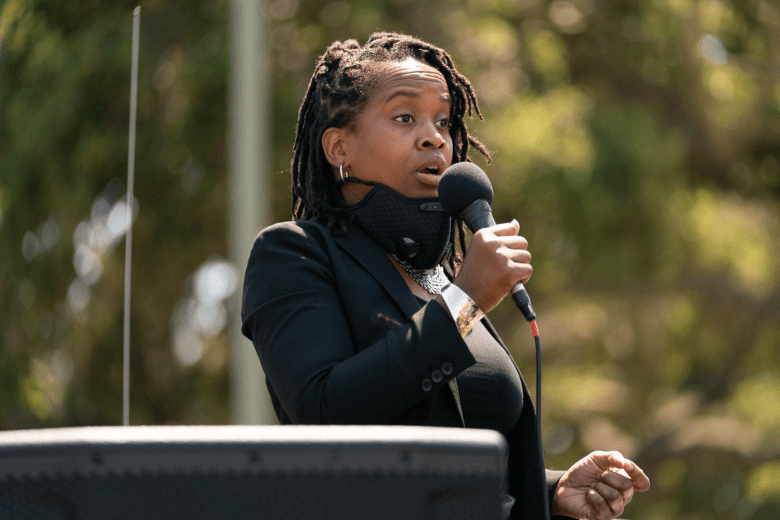Last Updated on November 16, 2023 by BVN
The City of Oakland passed a resolution declaring racism a public health crisis that included housing as a strategic action thus acknowledging the impact of inadequate housing on the city’s Black community that accounted for 70% of the city’s homeless population in 2022. The city also committed to securing funds to address systemic racism and equity through data collection. The resolution, however, does not include a commitment to require equity training for all government employees.
Breanna Reeves
Editor’s Note: Mapping Black California (MBC), created by Black Voice News, is a project that aims to collect and publish data to help eliminate systemic inequalities. One of MBC’s projects is an interactive map of official declarations by local and regional government officials establishing racism as a public health crisis. The aim of this is to provide a resource for tracking and holding these entities accountable for following through on declarations and statements. For this series, Black Voice News partnered with The Starling Lab for Data Integrity, a research lab anchored at Stanford University’s School of Engineering and the University of Southern California’s Shoah Foundation. The Lab prototypes authentication technologies and principles to bring journalists, legal experts and archivists into the emerging world of the decentralized web. These tools underscore the importance of accuracy and serve to combat mis- and disinformation. Decentralized tools can create a technological chain that identifies the history, or “provenance,” of a piece of digital content, serving to reduce information uncertainty and bolster trust in digital content. To learn more about these technologies, click here.
Two years after most cities and organizations declared racism a public health racism, the City of Oakland decided to make the same declaration on June 7, 2022. While the city’s decision to pass the resolution came later, Oakland is recognized as having one of the most inclusive resolutions, according to a Racism as a Public Health Crisis dashboard created by Mapping Black California (MBC), an Inland Empire-based data project of the Black Voice News.
In MBC’s examination of Oakland’s resolution, the research team noted the city is the only one among those who have made declarations to include housing as a strategic action and is one of seven resolutions that committed to securing funds to address systemic racism and equity through data collection.
Oakland’s resolution acknowledged that poor health “is both a root cause and a consequence of inadequate housing,” severely impacting Oakland’s Black community which accounted for about 70% of the city’s homeless population in 2022, but make up roughly 20% of the entire population, according to Alameda County’s 2022 Point-in-Time Count.
“The areas that we outlined in the resolution are the areas that we’re seeing extreme disparity that need immediate resolution,” explained Oakland Councilmember Carroll Fife. “That’s one of the things, regardless of race, all elected officials should be fighting for, because much of the current outcomes that we’re experiencing are the direct result of policymaking that was, quite frankly, just flat out racist.”
Prior to becoming Oakland’s District 3 representative, Fife was an organizer and advocate for housing — and still is. As a council member, Fife aims to transform the system so that it works for Black people and communities of color. Oakland’s declaration was a step in the right direction in addressing Oakland’s history of displacing Black residents and reaffirming the city’s pledges to do better.
According to MBC’s dashboard, the city of Oakland’s resolution “falls short by not including a commitment to making racial equity training a requirement for all government employees.”
One reason Oakland’s resolution may not explicitly include a commitment to making racial equity training a requirement for all government employees is because that commitment has been underway since 2016 when the city named Darlene Flynn the executive director of the Department of Race & Equity (DRE).
Under the direction of Flynn, her staff of four works with over 20 departments conducting customized anti-racist training and coaching 500 to 1,000 people per year. Unlike most cities, Flynn’s department is tasked with being internal consultants who use an anti-racist model to educate and coach people on how to take action in order to transform institutions. The department did not instigate the city’s decision to pass the resolution, but did assist in writing the resolution.
Flynn explained that these resolutions are very often “highly performative or symbolic,” and noted that her department does not specialize in symbolic work. Instead, they are focused on creating tangible change through action.
“We wanted to put some things in there that were tangible and action-oriented. We were the 15th or 16th city that I’m aware of to [make a declaration],” Flynn said. “It’s not like we were doing something particularly innovative, but I think what could have been different is that we were building on the fact that we’re already doing this work.”
The DRE uses a Theory of Change data-driven model in its approach to anti-racism at the city level to address root causes of inequity and eliminate them. Theory of Change methodology identifies strategies, conditions and resources to foster change and achieve outcomes.
Theory of Change is utilized by Crossroads Antiracism Organizing and Training, an organization that helps institutions identify social change strategies. Crossroads’ Theory of Change begins with “understanding the root of the problem is white supremacy, enshrined in and reproduced by our systems and institutions.” Flynn credits this organization for shaping her approach to addressing systemic inequity.
“It’s a hard pivot away from diversity and inclusion because diversity and inclusion does not put the organization on the table. What we’re doing is examining city practices, city outcomes, city impacts — it’s the city that we’re focused on as opposed to individuals,” Flynn detailed.
“If we can change the city so that it is behaving differently, we can impact more people’s lives.”
Inspired by anti-racist organizing framework by the People’s Institute for Survival and Beyond, an anti-racist collective of organizers and educators, Flynn has carried over learned practices from the organization.
Oakland’s Equity Indicators Report
In 2018, DRE launched its first Equity Indicators Report to establish a “baseline quantitative framework” that community members and city staff can refer to, to better understand the impacts of race and measure equity. The report, set to be updated every five years, is a way to support city staff and departments to make “data-driven” decisions about policies that will address inequity.
The report is structured across four levels: city-wide, theme, topic and indicator. Each level contains specific concepts and topics such as economy and public health that are measured for equity using quantifiable metrics on a scale from 1 to 100, “with 1 representing the highest possible inequity and 100 representing highest possible equity.”
The 2018 report found 12 indicators that received the lowest possible score, meaning the most extreme levels of inequities exist across these indicators. Among the 12 indicators were Education: Teachers – Representation of Student Population; Public Health: Child Health – Childhood Asthma Emergency Department Visits; Housing: Displacement – Homelessness; and Public Safety: Law Enforcement – Use of Force.
One of the focal points of Oakland’s resolution was data collection in order to measure inequity and track equity progress. The resolution specifically cited dedicating financial resources for demographic data collection, providing up to $350,000 in funding to the budget for a data analyst, and to update their equity indicators website with newly collected data. MBC’s analysis noted that Oakland’s resolution included all six Data & Accountability actions as outlined in the dashboard.
They often use whatever data they can find in order to analyze trends at the population level, but they aren’t experts at creating new and improved data.
“We want to be able to do data at the programmatic level, not just at the population level. Population level is a perfectly good place to start, but we want to be able to bring that analysis down to our service level or program level,” Flynn explained. “That means we have to figure out what we’re going to measure, how we’re going to measure it, what’s a meaningful measure, what’s not a meaningful measure.”
Hiring a data scientist has been a priority for the department and the city, however, the City of Oakland is experiencing a significant budget deficit of roughly $345 million during the Fiscal Years 2023-25. According to a city report, Oakland is “charged with resolving the largest projected General Purpose Fund shortfall in its history.” Due to the budget crisis, city departments have had to freeze open positions, which means that the city has been unable to hire a data analyst.
While there is a current hiring freeze across city departments, the data analyst position still exists and will be frozen until the budget deficit is solved. Flynn acknowledged how rare it is for city departments to have data analysts, especially in cities with less resources and that are predominantly communities of color.
Cities with larger populations of people of color tend to have less resources for several reasons including economic deficiencies as a result of inequitable practices carried out by cities, counties and even the state — “because even their implicit racism comes into play,” Flynn emphasized.
In the meantime, the DRE is working on updating and publishing the most recent indicators report with the data they do have available.
“This is not fast work, but it is effective work,” Flynn emphasized.
Activist leads fight for Black communities in Oakland
The City of Oakland may be one of the only city/local government resolutions to cite white supremacy as a root cause of longstanding inequities impacting Black people and communities of color at all social and economic levels.
“WHEREAS, a growing body of research on the social determinants of health shows how systemic racism and the legacy of centuries of racism and white supremacy, which endure to this day in the United States, have created and maintain inequities across every measurable category…,” the resolution noted.
“When we talk about racism as a public health crisis, we’re not just talking about Black Americans. We’re also talking about all of the different races who experience discrimination and obstacles [preventing them] from living the very best life that they can live,” Fife said.
In pursuit of transforming institutions and eliminating systemic inequity, taking steps to enact change can be challenging.
As a Black woman who strives to create policy and change the circumstances of Oakland’s Black community, Fife is finding it very challenging to accomplish the necessary tasks to transform current conditions.
The city attorney reached out to Fife to be part of the city’s resolution to declare racism a public health crisis given her activism on behalf of Black communities in Oakland and her legislation, the Black New Deal. The Black New Deal is a plan that seeks to create “city-wide policies and programs that reinvest in Black communities” across seven different sectors including environment, health, housing, and public safety.
Fife is encouraged by the unanimous support from the city, the mayor’s office, city staff and the legislative body who have been willing to address the factors that contribute to racism as a public health crisis and acknowledge the need for change.
But trying to rebuild or transform institutions is no small feat.
“Even if it weren’t about race, only about 50% of institutional change initiatives succeed. It’s a very high failure rate because, as it turns out, it’s very difficult to transform institutions,” Flynn noted.
Like Flynn, Fife is aware that there are limitations to enacting institutional change. While her primary goal is to transform and change the system so that it works for all people, Fife explained that she is prepared to extract whatever she can from the system and build something new, outside of the existing system.
“I still believe we need a parallel path, and since I’m here, let’s see what we can get done. I’m going to fight like hell to make it work,” Fife asserted.
Fife is constantly in communication with the public about the Black New Deal and conducting a study on issues that impact the residents of West Oakland, a predominantly Black neighborhood.
“Oakland’s ‘Black Dense’ Census Tracts”
Mapping researchers examined different factors like census tracts to determine population densities. West Oakland, a neighborhood within the City of Oakland, is identified as “Black dense” because Black people account for a great percentage of the city’s total population.
Oakland’s resolution is another step forward in addressing systemic racism and reconstructing an equitable institution that will prioritize the needs of Black communities and communities of color who have historically been underserved and divested of resources.
“I will be proud when we have the voracity to create positive outcomes for these groups, as much as we want to save a sports team,” Fife said.
“I will be proud when we invest the funds into making these new realized outcomes manifest for present and future generations, as much as we want to spend money to recreate the landscape for billionaires. I’m not quite there yet. I will be.”
Combating Racism as a Public Health Crisis
Part 1: Holding Leaders Accountable
Part 2: Santa Cruz County’s Inclusive Resolution
Part 3: Oakland Addresses Systemic Racism with Data-driven Approach
Part 4: Riverside and San Bernardino Counties Take Action Against Racism as a Public Health Crisis




